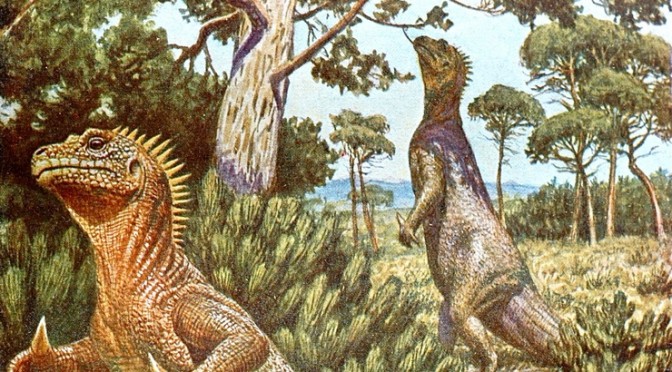By Ilja Nieuwland
The Danish artist-cum-scientist Gerhard Heilmann, who became famous for his book The Origin of Birds, published a little-known, short piece about Iguanodon a few years later, in an issue of Othenio Abel’s journal Palaeobiologica, dedicated to the Belgian paleontologist Louis Dollo. In many ways, this Iguanodon is much more ‘old-fashioned’ than his dynamic restorations in The Origin of Birds. First, it is positioned much more vertically. Although its tail doesn’t rest on the ground in the way that, for example, Charles Knight reconstructed his bipedal dinosaurs, it is still an altogether more stodgy-looking affair. This is further enhanced by the fact that the animal now looks very iguana- (and therefore reptile-) like.

Interestingly, an accompanying line drawing the animal’s head decreases that effect, but it’s still not quite as ‘modern’-looking as the 1926 reconstruction. In case you were wondering, Heilmann himself explains that:
[…] this reconstruction […] does not in the main features differ much from my former one (The Origin of Birds, Fig. 111), but the two running animals did not resemble reptiles at all.
One might counter that these animals look like (extant) reptiles rather too much. Worse, they don’t look like Iguanodons at all: the torso is far too elongated, and the skull too short. But also from an artistic viewpoint, this reconstruction is somewhat unsatisfying. In general, I think Heilmann’s pen drawings are much more effective than his colour work (the famous Archaeopteryx reconstruction being an exception, perhaps).
Nonetheless, it is interesting to see him reverting to a more conservative approach here, although I’m unsure where the significance of that may lie. However, as I’ve written before, it is clear that from the first drawings in 1912, Heilmann’s reconstructions become progressively more restrained. That is particularly the case with regard to the stance he lets his animals adopt: from the fighting Archaeopteryxes of 1914 we end with the courting couple we know so well from the 1926 edition.
Source: Gerhard Heilmann 1928, »A restoration of Iguanodon bernissartensis«, Palaeobiologica Dollo-Festschrift (Vienna & Leipzig: Emil Haim & Co.), pp. 101-102, 1 plate.
o-o-o
Ilja Nieuwland works at the Huygens ING, an institute of the Royal Netherlands Academy of Arts and Scienes. His specialization in the history of 19th- and 20th-century paleontology is an unfortunate but unavoidable consequence of the fact that he was never able to shake off the interest in dinosaurs he held as an eight-year-old

